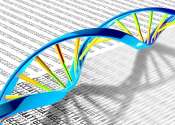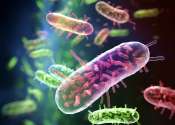Last update:
Molecular & Computational biology news

Gene-based model predicts when Japan's cherry buds awake from dormancy
Japan in spring is famous for its cherry blossoms, or sakura, which begin flowering in the southern region of Kyushu and blaze upwards to the remote north of Hokkaido. The most abundant cherry tree cultivar, Somei Yoshino, ...
Molecular & Computational biology
6 minutes ago
0
0

New technique zeros in on the genes that snakes use to produce venom
Only about 10% of the world's roughly 4,000 snake species have venom strong enough to seriously hurt a human, but that's enough for snake bites to be an important public health concern. To help better understand how snakes ...
Ecology
6 minutes ago
0
0

Scientists identify 18 bacterial strains to treat antibiotic-resistant gut infections
Antibiotic-resistant bacterial infections often occur in patients with chronic inflammatory intestinal conditions, such as inflammatory bowel disease, and in patients who have taken antibiotics for a long time. Gram-negative ...
Cell & Microbiology
16 hours ago
0
17

Scientists find new epigenetic switch, revealing how genes are regulated in early development
The team of Professor Christof Niehrs at the Institute of Molecular Biology (IMB) in Mainz, Germany, has discovered that a DNA modification called 5-formylcytosine (5fC) functions as an activating epigenetic switch that kick-starts ...
Molecular & Computational biology
16 hours ago
0
7

Silencing in action: How cells 'repress' genomic remnants of ancient viruses
Researchers have identified key cellular control sites that regulate gene expression and prevent the activation of "cryptic" genomic regions, including ancient viral sequences.
Cell & Microbiology
16 hours ago
0
28

Building better DNA editors: Retrons raise the bar for gene research
Within bacterial cells, specialized immune systems known as retrons fend off viral attacks. But that's not all they can do. Scientists, including Seth Shipman, Ph.D., at Gladstone Institutes, have shown that retrons also ...
Biotechnology
17 hours ago
0
11

New kit makes classroom CRISPR experiments affordable and accessible
CRISPR, the gene-editing technology, has been one of the major breakthroughs in biology in the last two decades. And while students learn about the capability to cut, paste, and alter genes, it's rare that they get the chance ...
Biotechnology
18 hours ago
0
117

Research boosts understanding of sorghum's pest resistance
Husker scientists have identified a key plant hormone that strengthens sorghum self-protection against the threat of the sugarcane aphid. The project is part of the university's wide-ranging, multidisciplinary work to advance ...
Molecular & Computational biology
18 hours ago
0
1

Computational tool can pinpoint causal relationships from complex biological data
Researchers have developed a tool that provides new insights into cause-and-effect relationships between cells and how these change over time.
Cell & Microbiology
Sep 17, 2024
0
54

Do bacteria age?
Any organism that lives, grows and reproduces must also age. People often think of aging in the physical sense—gray hair, slowed movements and wrinkles—but aging fundamentally occurs on a molecular level, inside of cells.
Cell & Microbiology
Sep 17, 2024
0
4

An unexpected protein connection in maize growth and defense could enhance crop resilience
Maize (corn) is one of the most important staple crops in the world and has been extensively studied. Yet, many aspects of the genetic mechanisms regulating its growth and development remain unexplored.
Molecular & Computational biology
Sep 17, 2024
0
26

Scientists from 33 European countries join forces to generate reference genomes for the continent's biological diversity
In a new publication, the European Reference Genome Atlas (ERGA) announces the success of its pilot project. This initiative assembled a large collaborative network of scientists and institutions across 33 countries to produce ...
Plants & Animals
Sep 17, 2024
0
10

Scientists decipher the energy patterns in our cells
Our cells harness energy for essential functions such as division, wound healing, and our immune response to diseases including cancer. But until now, the mechanics of how that energy affects cell behavior—and how this ...
Cell & Microbiology
Sep 17, 2024
0
8

Are kiwi and moa recent immigrants from Australia? Neither fossils nor genetic evidence support the story
Aotearoa New Zealand is a land of birds, from the smallest of wrens to the mightiest of moa. The ancestors of some species have been here for tens of millions of years, while others arrived only a few million years ago.
Molecular & Computational biology
Sep 17, 2024
0
26

Label-free optical tech takes power and efficiency of biological sensing to record level
University of Arizona researchers have developed a new biological sensing method that can detect substances at the zeptomolar level—an astonishingly miniscule amount.
Biotechnology
Sep 17, 2024
0
40

Mathematical model explains how plant communities change when conquering uninhabited ground
Some plants are able to take over uninhabited spaces like sand dunes and volcanic substrates. These first colonizers have specific traits that allow them to grow in such hostile environments. Other plants lack such traits ...
Ecology
Sep 17, 2024
0
26

Discovery paves the way for antivirals against Ebola virus and its deadly relatives
At this moment, the world has few tools to combat deadly filoviruses, such as Ebola and Marburg viruses. The only approved vaccine and antibody treatments protect against just one filovirus species.
Cell & Microbiology
Sep 17, 2024
0
26

Scientists discover how TGF-Beta sends its message even while tethered to the cell membrane
For years, scientists have thought that TGF-Beta, a signaling protein that holds sway over an astonishing array of cellular processes from embryonic development to cancer, could only do its work once it escaped a lasso-like ...
Cell & Microbiology
Sep 16, 2024
0
19

Optogenetic control reveals collective cell behavior
New research led by the Institute for Bioengineering of Catalonia (IBEC) has studied the migratory movement of groups of cells using light control. The results show that there is no leader cell that directs the collective ...
Biotechnology
Sep 16, 2024
0
55

Sunflowers make small moves to maximize sun exposure—physicists can model them to predict how they grow
Most of us aren't spending our days watching our houseplants grow. We see their signs of life only occasionally—a new leaf unfurled, a stem leaning toward the window.
Plants & Animals
Sep 16, 2024
0
3
More news

Genomics reveals sled dogs' Siberian lineage

How bacteria actively use passive physics to make biofilms

Proteins involved in regulating the cell membrane could lead to new treatments

Rapid diagnostics tool deployed to monitor wheat rust in Nepal

Scientists use egg yolk to stabilize paprika oleoresin

Researchers identify novel approach to minimize nitrogen loss in crops

International team discovers new process for cells to repair DNA damage

Killer toxins produced by yeast may help remedy a craft beer brewing bother

Researchers aim to control gene expression by studying the memories of cells
Other news

Why petting your cat leads to static electricity

Can toddlers help explain the origins of our bias for wealth?

Ocean waves grow way beyond known limits, new research finds

Another new wasp species discovered by researchers

Organization of DNA in chromosomes can be explained by weak interactions between nucleosomes, research suggests

Strengthening crop stems: New insights from pepper plant genetics

Unlocking the genetic secrets of red-flesh apples—a bittersweet discovery

Revitalizing pak choi: Unveiling the genetic mechanisms behind drought tolerance

Human 'molecular map' contributes to the understanding of disease mechanisms

Newly discovered antimicrobial could prevent or treat cholera








































